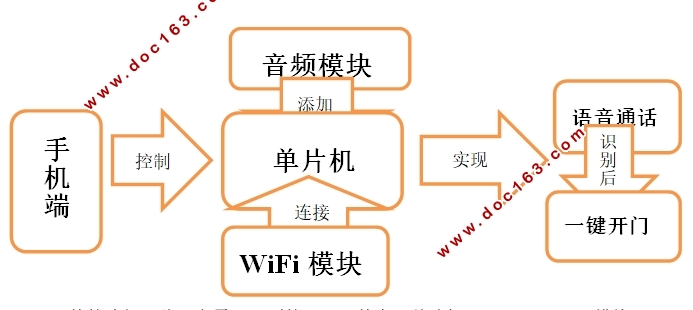基于无线通信的多功能家居门铃的硬件设计

基于无线通信的多功能家居门铃的硬件设计(论文13700字)
摘要:本设计首先对普通的家居门铃做出调查分析,发现现有门铃系统大多由通信导线进行信息传输。针对这一现象,设计了一款通过2.4GHz无线进行通信的多功能家居门铃系统,在保持现有门铃系统功能不变的情况下,添加指纹模块,可用指纹来一键开门,该多功能门铃包含三个功能:远程开门、对讲功能与指纹解锁。本系统以STM32为主控,将门铃系统分为户外端和户内端。户外端由STM32单片机、音频模块(包括麦克风和扬声器)、nRF24L01无线通信模块、指纹识别模块、继电器、呼叫按键等组成;户内端由STM32单片机、音频模块(包括麦克风和扬声器)、nRF24L01无线通信模块、开门按键等组成。本系统对原有的门铃系统做出了改进,减少了通信线材的使用,为家居门铃系统的智能化提供了一种新思路。
关键词:STM32、2.4GHz无线通信、指纹识别
Hardware Design of Multifunctional Home Door Bell
Hanlibo
School of Electronic Information Engineering, Nanjing University of Information Engineering, Nanjing 210044, Jiangsu Province
ABSTRACT:This design first makes an investigation and analysis of the ordinary home doorbell, and finds that most of the existing doorbell systems are transmitted by communication wires. In order to solve this problem, a multi-functional home doorbell system which communicates by 2.4 GHz wireless is designed. With the function of the existing doorbell system unchanged, fingerprint module is added to open the door with one click of fingerprint. The multi-functional doorbell contains three functions: remote door opening, intercom function and fingerprint unlocking. The system is mainly controlled by STM32. The doorbell system is divided into outdoor and indoor terminals. The outdoor end is composed of STM32 single-chip computer, audio module (including microphone and speaker), nRF24L01 wireless communication module, fingerprint identification module, relay, call button, etc. The indoor end is composed of STM32 single-chip computer, audio module (including microphone and speaker), nRF24L01 wireless communication module, open door button, etc. This system improves the original doorbell system, reduces the use of communication wires, and provides a new idea for the intellectualization of home doorbell system.
Key words:STM32, 2.4 GHz Wireless Communication, Fingerprint Recognition
[资料来源:www.doc163.com]

目录
1.绪论……………………………………………………………………………………………………………3
1.1研究的背景 ………………………………………………………………………………………3
1.2国内外研究现状 …………………………………………………………………………………3 [资料来源:Doc163.com]
1.2.1目前国外智能家居的研究现状 …………………………………………………………3
1.2.2目前国内智能家居的研究现状 …………………………………………………………4
1.3论文主要内容 ……………………………………………………………………………………4
2.方案的选择及相关硬件技术介绍…………………………………………………………………………… 5
2.1 方案的选择……………………………………………………………………………………… 5
2.1.1方案A—基于手机终端的智能家居门铃的硬件设计……………………………………5
2.1.2方案B—基于WiFi通信的多功能智能家居门铃系统的硬件设计[14] …………………6
2.1.3方案C—基于无线通信的多功能家居门铃系统的硬件设计(最终方案) ……………6
2.2 相关硬件技术介绍……………………………………………………………………………… 7
2.2.1 STM32单片机结构原理……………………………………………………………………7
2.2.2 51单片机结构原理 ………………………………………………………………………7 [资料来源:http://www.doc163.com]
2.2.3 nRF24L01+ 的原理……………………………………………………………………… 8
2.2.4 半双工通信……………………………………………………………………………… 9
2.2.5 指纹识别技术……………………………………………………………………………10
3.系统一:门铃的语音对讲模块的硬件设计 ………………………………………………………………11
3.1 语音对讲模块的总设计…………………………………………………………………………11
[资料来源:http://doc163.com]
3.2 51单片机的设计…………………………………………………………………………………12
3.3 nRF24L01+无线模块的设计[16] …………………………………………………………………12
3.3.1模块特点…………………………………………………………………………………13
3.3.2天线………………………………………………………………………………………14
3.3.3状态字处理………………………………………………………………………………14
3.4 音频功率放大器…………………………………………………………………………………15
4.系统二:指纹模块的硬件设计 ……………………………………………………………………………15
4.1 STM32单片机的设计……………………………………………………………………………15 [资料来源:https://www.doc163.com]
4.2指纹模块ATK-AS608……………………………………………………………………………17
4.2.1 ATK-AS608指纹识别模块简介…………………………………………………………17
4.2.2 主要技术指标……………………………………………………………………………17
4.3 指纹模块的硬件开发……………………………………………………………………………18
4.4 指纹模块的硬件设计……………………………………………………………………………19
5.整体实物与测试……………………………………………………………………………………………19
5.1 对讲系统模块……………………………………………………………………………………20
5.1.1 实物图展示………………………………………………………………………………20
5.1.2 半双工对讲模拟机的介绍………………………………………………………………20
5.1.3 测试后的通信距离………………………………………………………………………20
5.1.4缺点的总结………………………………………………………………………………21
5.2 指纹认证开门模块………………………………………………………………………………21
5.2.1 实物图展示………………………………………………………………………………21 [资料来源:https://www.doc163.com]
5.2.2 指纹模块的功能实现流程………………………………………………………………21
5.2.3 指纹模块出现的问题……………………………………………………………………21
6.总结与展望…………………………………………………………………………………………………21
6.1 本次设计的成果…………………………………………………………………………………21 [资料来源:http://www.doc163.com]
6.2 本次设计所出现的问题…………………………………………………………………………22
6.3 本次设计还可做出的研究………………………………………………………………………22
参考文献………………………………………………………………………………………………………22
致谢……………………………………………………………………………………………………………24
